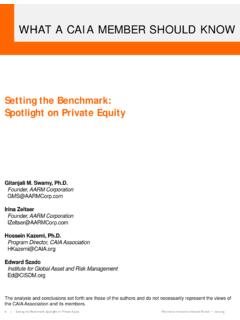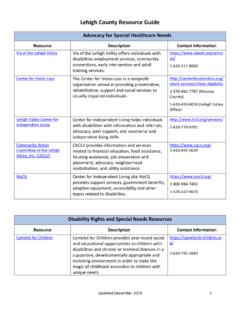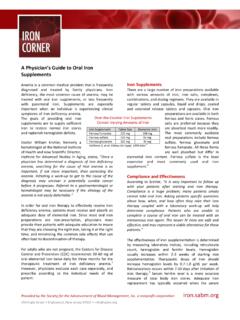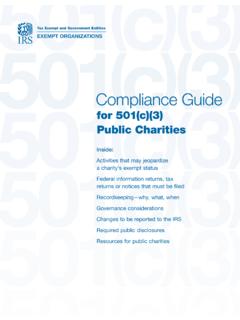Transcription of Understanding the Cost of Investment Management
1 Understanding the Cost of Investment ManagementOctober 2015 Understanding the Cost of Investment Management : A Guide for Fiduciaries Table of ContentsIntroduction 1 Calculating Costs 2 The Structure of Costs 3 Understanding Cost Components 5 Calculating Costs 7 Outsourcing Costs 8 Conclusion 9 Appendix: What We Know about Costs 10 AuthorWilliam F. JarvisManaging Director Commonfund Institute Commonfund InstituteCommonfund Institute houses the education and research activities of Commonfund and provides the entire community of long-term investors with Investment information and professional development programs.
2 Commonfund Institute is dedicat-ed to the advancement of Investment knowledge and the promotion of best practices in financial Management . It provides a wide variety of resources, including conferences, seminars and roundtables on topics such as endowments and treasury Management ; proprietary and third-party research such as the NACUBO Commonfund Study of Endowments; publications including the Higher Education Price Index (HEPI); and events such as the annual Commonfund Forum and Commonfund Endowment the Cost of Investment Management : A Guide for Fiduciaries 1A guide for fiduciariesUnderstanding the Cost of Investment ManagementIntroductionFew aspects of financial Management are more important for fiduciaries than an Understanding of the costs paid for the Management of the perpetual funds for which they have responsibility.
3 Indeed, astute Management of costs can make the difference between mediocrity and superior per-formance in otherwise identical portfolios. But unlike other factors that affect Investment returns, such as asset alloca-tion and the many types of operational and Investment risk, costs are almost certainly the least well understood. In this paper, we introduce the various types of costs that investors pay both disclosed and undisclosed and provide repre-sentative ranges for each type of cost. Our aim is to guide fiduciaries as they strive to fulfill their duties under common and statutory law and to provide Investment managers with a guide to best Institute s national surveys of endowments and foundations confirm a low level of Understanding with respect to costs.
4 To take one example, of the 832 insti-tutions of higher education participating in the 2014 NA-CUBO-Commonfund Study of Endowments (NCSE), the 717 that responded to the suite of questions regarding costs incurred in managing their Investment program estimated a median all-in cost of 50 basis points, or percent. But very few of these institutions were able to provide specific breakdowns, although most could name the components of those costs by category. And while some cost categories were clearly familiar, others were cited less frequently. For example, 86 percent said that their cost total included asset Management fees and mutual fund expenses; 64 percent cited consultant and outsourcing fees; and 56 percent in-cluded direct expenses.
5 But only 18 percent included incen-tive and performance fees paid to asset managers, despite the fact that nearly 85 percent of NCSE respondents, or 704 institutions, reported having asset allocations to alternative Investment strategies. Clearly, a gap exists between practice and Understanding with respect to certain types of costs. 1In a similar vein, in early 2015 Commonfund conducted a survey of the fiduciaries financial officers and trustees attending the Commonfund Forum annual investor confer-ence. In response to the question, What are the total fees and expenses you pay to Investment advisers, managers, consultants and custodians (in basis points)?
6 , 81 percent of the 193 survey respondents estimated their annual costs at less than 100 basis points, while 19 percent said their costs were greater than 100 basis points. Eighteen percent of respondents estimated their costs at less than 50 basis points, while 14 percent put them at over 130 basis points. These data points support a few preliminary observations. As the NCSE responses point out, the categories that are included in overall cost estimates vary widely. In addition, 1 For a more detailed review of the NCSE and other Com-monfund Institute data on costs, see the Appendix, What We Know about Costs.
7 2 Understanding the Cost of Investment Management : A Guide for Fiduciaries the fact that almost 15 percent of NCSE participants did not provide cost data at all suggests that they may not have known what their costs were or were uncertain about them. A more detailed estimate of total costs comes from Com-monfund s investor services group, which analyzes costs for some 80 client organizations each year. The results of these analyses suggest that costs are significantly higher than the median 50 basis points reported in the NCSE. In general, average costs appear to be no less than 100 basis points and can range up to 175 basis points or more for more com-plex portfolios.
8 It is this level of detail that is missing from the self-reported numbers, and which we hope to illuminate range of factors may cause costs to vary from institution to institution, even among those of similar size and type. But it is clear that a fuller Understanding of the costs associated with managing institutional nonprofit funds is needed. In this paper, we attempt to accomplish three goals: To provide an overview of the various types of costs, both disclosed and undisclosed, that nonprofit institu-tions are likely to incur in investing their long-term pools, together with representative cost ranges; To help fiduciaries to understand the derivation of these costs; and To enable them to address well-informed questions about disclosed and undisclosed costs to Investment service providers.
9 Why Costs MatterFees are known indeed, they are frequently set out in detail in a manager s or service provider s invoice and can, therefore, be analyzed and controlled. Costs, on the other hand, are not necessarily invoiced and can be much harder to understand and control. The problem is exacerbated by the fact that different types of long-term Investment pools report their Investment performance in different ways. Nonprofit organizations such as colleges, universities, independent schools, foundations, operating charities and healthcare organizations generally report their Investment results net of costs.
10 The practice among public pension plans, however, is typically to report returns in gross terms. Because fees and costs both disclosed and undisclosed determine what institutions get to keep and spend in support of their missions, it is important to understand their nature and range. Furthermore, as a fiduciary matter, several compelling reasons exist to support a better comprehension of cost issues: As transparency becomes the norm in the nonprofit sector, driven by the disclosures required by the expand-ed IRS Form 990 and by social forces that encourage in-creased openness, trustees and senior staff are expected to understand the total cost that their organization pays for Investment Management as part of their fiduciary duty of care.







